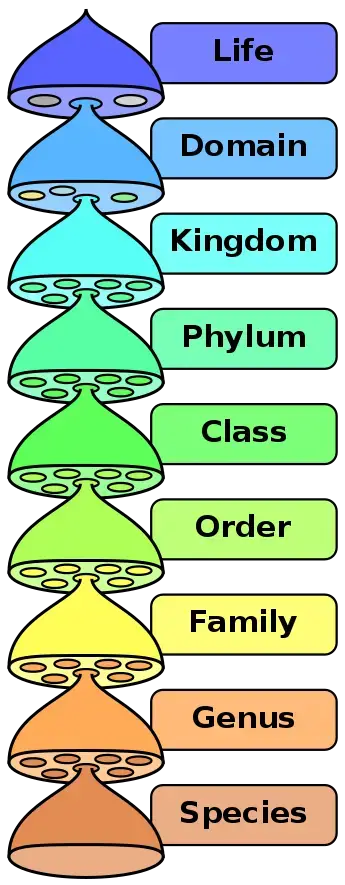What is Genus?
- In the intricate tapestry of biological classification, the term “genus” occupies a pivotal position. A genus, denoted in Latin as “genus” (plural: genera), is a taxonomic rank that serves as a nexus between species and family. It is an assembly of species that exhibit shared characteristics or are phylogenetically interrelated, signifying their evolutionary lineage from a common ancestor.
- The taxonomic hierarchy, a structured system of classification, places the genus above species and below the family. To elucidate, within the family Felidae, which encompasses cat-like creatures, the genus Panthera is situated. This genus includes species such as Panthera leo (lion) and Panthera onca (jaguar). Each species within a genus is demarcated by a unique set of traits, yet they all share a broader set of characteristics at the genus level.
- The binomial nomenclature, a system introduced by the eminent zoologist Carl Linnaeus, employs the genus as the inaugural component of a species’ scientific name. This name is typically italicized, for instance, Homo sapiens, or underlined when handwritten. The genus name, or the generic epithet, is always capitalized, while the specific epithet, which denotes the species, follows in lowercase.
- The criteria for classifying organisms into a particular genus are not universally standardized. However, certain guiding principles are generally accepted within the scientific community:
- Monophyly: The genus should encompass all descendants of a particular ancestral taxon.
- Compactness: A genus should not be overly expansive without justification.
- Distinctness: Organisms within a genus should exhibit distinct evolutionary criteria, be it ecological, morphological, or biogeographical.
- The genesis of the term “genus” traces back to Latin, where it signifies “birth” or “origin.” The concept, though popularized by Linnaeus in the 18th century, owes its foundational roots to the French botanist Joseph Pitton de Tournefort.
- As of recent estimates, approximately 510,000 genus names have been documented. This number is a testament to the vast biodiversity of our planet and the continual efforts of taxonomists to classify and understand it. With advancements in technology, especially DNA analysis, the classification and understanding of genera are in a state of dynamic evolution. Such tools allow for a more nuanced understanding of evolutionary relationships, leading to the reclassification of organisms and the identification of new genera.
- In summation, the genus serves as a crucial bridge in the taxonomic hierarchy, connecting the specific traits of species with the broader characteristics of families. It is a reflection of the evolutionary history and shared lineage of organisms, providing a window into the intricate web of life on Earth.

Definition of Genus
A genus is a taxonomic rank in biological classification that groups together species with shared characteristics or evolutionary lineage, positioned above species and below family.
Classification System
- Biological classification is the systematic arrangement of living entities based on a hierarchical structure, encompassing their distinct attributes and evolutionary relationships. This methodical approach is integral to the discipline of taxonomy, which delves into the categorization, naming, and study of organisms.
- The taxonomic hierarchy comprises several levels, each progressively narrowing down the classification from a broad spectrum to specific entities. These levels, starting from the most inclusive to the most specific, are: Domain, Kingdom, Phylum, Class, Order, Family, Genus, and Species. Within this structure, the genus acts as an intermediary rank, situated between the broader family and the more specific species.
- The linchpin of modern taxonomy, Carl Linnaeus, a renowned Swedish botanist, played a pivotal role in formulating a structured system for naming organisms. This system, termed “Binomial Nomenclature,” prescribes a set of conventions for assigning scientific names to organisms. Under this system, every organism is designated a two-part name: the first part denotes the genus, and the second part, known as the specific epithet, pinpoints the species within that genus.
- In adherence to the conventions of binomial nomenclature, the genus name is always italicized and capitalized. To illustrate, in the binomial name Panthera leo, “Panthera” represents the genus of the lion, while “leo” serves as the specific epithet, highlighting the particular species within the Panthera genus.
- In essence, the classification system provides a structured framework, facilitating the systematic study, understanding, and communication about the vast diversity of life on Earth. Through this organized approach, scientists can discern relationships, trace evolutionary paths, and ensure clarity in the nomenclature of organisms.
The Naming System
In the realm of biological taxonomy, the system of binomial nomenclature stands as a cornerstone for naming organisms. This system ensures clarity, precision, and uniformity in the identification and classification of species across the globe.
- Structure of Binomial Nomenclature:
- Genus: The initial component of a scientific name, the genus is always capitalized and italicized. It serves as a broader categorization, grouping together species with shared characteristics.
- Specific Epithet: Following the genus, the specific epithet is the second part of the binomial name. It is always in lowercase and italicized. This epithet pinpoints the exact species within the genus.
- Criteria for Genus Classification:
- Monophyly: As articulated by Willi Hennig, a genus should be monophyletic, meaning it should be based on shared derived characteristics that set it apart from other organism groups.
- Reasonable Compactness: A genus should not be needlessly expansive. It should be concise, encompassing only those species that genuinely belong within its purview.
- Distinctness: The genus should exhibit clear differentiation based on evolutionarily significant criteria, be it ecological, morphological, or biogeographical.
- Role of Taxonomists: Experts in taxonomy, taxonomists are responsible for assigning scientific names to species. Their work is guided by rigorous scientific principles and methodologies to ensure accuracy and consistency.
- Nomenclature Codes: These codes serve as the guiding standards for naming organisms. They ensure that the naming process adheres to universally accepted conventions, thereby promoting consistency and clarity in the scientific naming of organisms.
- Binomial vs. Vernacular Names: While binomial names are standardized and universally accepted, vernacular or common names are non-standardized and can vary based on regions or cultures. For instance, while Panthera leo is the standardized scientific name for the lion, its common names might differ across languages and regions.
In summary, the binomial nomenclature system is a meticulously crafted naming convention that ensures clarity, uniformity, and precision in the scientific naming of organisms, providing a standardized approach to taxonomy.
Difference between genus and species
In the realm of biological taxonomy, the terms “genus” and “species” are fundamental. Both play pivotal roles in the classification and naming of organisms, yet they differ in their scope, definition, and application. Herein, we elucidate the distinctions between these two taxonomic ranks.
- Definition:
- Genus: A taxonomic rank that groups together species sharing certain common features. It is positioned below the family rank and above species in the taxonomic hierarchy.
- Species: The most basic and fundamental unit in biological classification. It encompasses organisms that can interbreed to produce fertile offspring. Members of the same species share a common DNA set, exhibit similar morphological traits, and often demonstrate shared behaviors.
- Scope:
- Genus: Being a higher taxonomic rank than species, a genus is more inclusive. It encompasses multiple species that share certain commonalities.
- Species: More specific and less inclusive than a genus, a species consists of organisms that can reproduce with one another to yield fertile progeny.
- Interbreeding:
- Genus: While it groups together species based on shared characteristics, organisms from different species within the same genus typically cannot interbreed to produce fertile offspring.
- Species: Organisms within a species can interbreed and produce fertile offspring. This reproductive compatibility is a defining feature of a species.
- Binomial Nomenclature:
- Genus: In the binomial naming system, the genus serves as the first component and is the generic name. It is always capitalized.
- Species: The species name follows the genus and is the specific epithet in the binomial nomenclature. It is always written in lowercase.
- Examples:
- Genus: An example of a genus is Homo.
- Species: Within the genus Homo, an example of a species is H. sapiens, referring to modern humans.
- Subdivisions:
- Genus: While the genus is a broader category, it does not typically have further subdivisions.
- Species: Some species can be further divided into subspecies or other subcategories, such as varieties or formae.
In summation, while both genus and species are integral to the taxonomic classification of organisms, they differ in their definitions, inclusivity, and roles in the binomial naming system. Understanding these distinctions is crucial for accurate classification and nomenclature in biology.
| Aspect | Genus | Species |
|---|---|---|
| Definition | A taxonomic rank grouping species with common features. | The most basic unit in biological classification, encompassing organisms that can interbreed. |
| Scope | More inclusive, encompassing multiple species with shared characteristics. | Specific and less inclusive, consisting of organisms that can reproduce to yield fertile progeny. |
| Interbreeding | Organisms from different species within the same genus typically cannot produce fertile offspring. | Organisms within a species can interbreed and produce fertile offspring. |
| Binomial Nomenclature | Serves as the first component (generic name) and is always capitalized. | Follows the genus as the specific epithet, always in lowercase. |
| Examples | Homo | H. sapiens (within the genus Homo) |
| Subdivisions | Typically does not have further subdivisions. | Can be further divided into subspecies or other subcategories like varieties or formae. |
Subgenus
In the intricate hierarchy of biological classification, the taxon “subgenus” is positioned immediately below the rank of genus. This taxonomic rank is introduced by taxonomists for several compelling reasons:
- Diversity within Genera: When a genus encompasses a multitude of species, there can be pronounced variations in aspects such as morphology, genetics, and behavior. A subgenus aids in categorizing these diverse entities more precisely.
- Evolutionary Relationships: The introduction of a subgenus can highlight distinct evolutionary divergences within a genus, especially when there are clear patterns of divergence between clades.
- Ecological and Geographic Variation: In instances where species within a genus exhibit significant ecological or geographical differences that have influenced their speciation, a subgenus can be instrumental in demarcating these variations.
- Conservation Priorities: The designation of a subgenus can be pivotal for conservation strategies. It allows for targeted conservation efforts, especially when a subgenus comprises multiple species that are endangered or threatened.
To illustrate the concept of subgenus, consider the following examples:
- The genus Pan is divided into the subgenera Pan (Pan) for the common chimpanzee and Pan (Paniscus) for the bonobo.
- Within the genus Felis, Felis (Felis) catus represents the domestic cat, whereas Felis (Silvestris) lybica denotes the African wildcat.
- The genus Rosa is bifurcated into the subgenera Rosa subgenus Rosa for true roses and Rosa subgenus Caninae for dog roses.
- The genus Musa is categorized into Musa subg. Eumusa, which includes most edible banana species, and Musa subg. Rhodochlamys, encompassing certain wild banana species.
In terms of nomenclature:
- The use of a subgenus is optional when naming a species.
- The International Code of Zoological Nomenclature advises placing the subgeneric name within parentheses, situated between the generic name and the specific epithet.
- Conversely, the International Code of Nomenclature for algae, fungi, and plants suggests the inclusion of a connecting term, often abbreviated as “subg.”, which is presented in a non-italicized format.
In essence, the subgenus serves as a nuanced layer in the taxonomic hierarchy, providing a more granular classification and facilitating a deeper understanding of the relationships and variations within a genus.
Examples of Genus
The taxonomic classification of living organisms is a meticulous endeavor, and within the hierarchy of this system, the genus plays a pivotal role. It groups together species that share common characteristics and evolutionary lineage. One of the most studied and significant genera in the context of human evolution is the genus Homo.
The genus Homo, derived from Latin meaning “man,” is a representative of the tribe Hominini, falling under the family Hominidae. This genus is characterized by several distinctive features, including bipedal locomotion, an opposable thumb, a vertebral column replacing the notochord, live birth, and mammary glands in females that produce milk for offspring. Within the genus Homo, multiple species have been identified, but only Homo sapiens sapiens (modern humans) persists today. Some notable species within this genus include:
- H. habilis
- H. rudolfensis
- H. gautengensis
- H. erectus
- H. ergaster
- H. antecessor
- H. heidelbergensis
- H. cepranensis
- H. rhodesiensis
- H. naledi
- H. neanderthalensis
- H. floresiensis
- H. tsaichangensis
- Denisova hominin
- Red Deer Cave people
These species, belonging to the genus Homo, are distinguished by their advanced cognitive abilities, including abstract reasoning, problem-solving, and articulate communication. Their bipedal stance and comparatively smaller dental structures differentiate them from other primates.
Another genus pivotal to the discussion of human evolution is Australopithecus. Members of this genus had brains approximately 35% the size of modern humans and exhibited physical characteristics more akin to modern-day chimpanzees and bonobos, including a smaller stature and a body covered in hair. Despite these differences, Australopithecus is crucial in understanding human evolution, as it is believed that the genus Homo evolved from a species within this genus.
Other genera, such as Ardipithecus and Sahelanthropus, also provide insights into the evolutionary journey of hominids. While Ardipithecus members are believed to have characteristics more aligned with chimpanzees, Sahelanthropus represents species from the Miocene epoch, a time close to the divergence of chimpanzees and humans.
In summary, the exploration of various genera, especially within the Hominidae family, offers invaluable insights into the evolutionary trajectory of humans, shedding light on our shared ancestry and the unique characteristics that define us.
Advantages of Genus
The classification of organisms into genera offers several advantages in the realm of biological taxonomy and beyond:
- Systematic Organization: Grouping species into genera provides a structured and systematic way to categorize the vast diversity of life. This organization simplifies the study and understanding of organisms.
- Facilitates Identification: Knowing the genus of an organism can significantly aid in its identification. Species within a genus often share certain recognizable characteristics, making identification more straightforward.
- Evolutionary Insights: Classifying organisms into genera can provide valuable insights into their evolutionary history and relationships. It helps in understanding how different species within a genus have evolved and diverged from a common ancestor.
- Standardized Nomenclature: The genus is an integral part of the binomial nomenclature system, ensuring a standardized naming convention for organisms worldwide. This uniformity aids in clear communication among scientists globally.
- Guides Research: By understanding the genus of an organism, researchers can make informed predictions about its biology, behavior, and ecology, based on what is known about other members of the genus.
- Conservation Efforts: Recognizing the genus of threatened or endangered species can guide conservation strategies. Efforts can be directed towards conserving an entire genus, especially if multiple species within it are at risk.
- Economic and Agricultural Relevance: In agriculture, knowing the genus of plants can be crucial for crop breeding, pest management, and disease control. Plants within the same genus might have similar vulnerabilities or resistances.
- Medical and Pharmaceutical Implications: In medicine and pharmacology, understanding the genus of organisms can be essential. For instance, plants or microbes from a particular genus might be sources of medicinal compounds or potential pathogens.
- Enhances Communication: Using the genus as a reference point facilitates clearer communication among biologists, ensuring that they are discussing the same group of organisms without ambiguity.
- Phylogenetic Context: The genus provides a level of classification that is useful for constructing and interpreting phylogenetic trees, helping to elucidate the evolutionary relationships between different groups of organisms.
In summary, the concept of the genus in biological taxonomy offers a multitude of advantages, from facilitating systematic organization and research to guiding conservation and economic endeavors.
Limitations of Genus
While the classification of organisms into genera offers numerous advantages, there are also inherent limitations and challenges associated with this taxonomic rank:
- Subjectivity: The criteria for defining a genus can sometimes be subjective. Different taxonomists might have varying opinions on what constitutes a genus, leading to inconsistencies in classification.
- Fluidity of Classification: As scientific knowledge advances, especially with the advent of molecular biology and genetic sequencing, the classification of certain organisms into specific genera may change. This can lead to confusion and the need for reclassification.
- Overlapping Characteristics: Some species may exhibit characteristics that overlap with multiple genera, making it challenging to classify them definitively into one genus.
- Potential for Polyphyly: There’s a risk that a genus might become polyphyletic, meaning it includes species derived from more than one ancestral lineage. Such a classification would not accurately reflect evolutionary relationships.
- Incomplete Information: In some cases, especially with extinct organisms known only from fossil records, there might not be enough information to accurately place them within a specific genus.
- Limitation in Detail: While the genus provides a broader classification, it might not capture the finer details and variations present at lower taxonomic levels, such as species or subspecies.
- Interbreeding Ambiguities: Some species from different genera can interbreed and produce fertile offspring under certain conditions, challenging the traditional definitions based on reproductive isolation.
- Evolutionary Rates: Different lineages might evolve at different rates. Some might diversify rapidly, leading to many species in a short time, while others might remain stable. This can make it challenging to define genera based solely on time or evolutionary divergence.
- Reliance on Morphology: Historically, genera were often defined based on morphological characteristics. However, morphology can be misleading, as convergent evolution can lead to similar features in unrelated species.
- Inconsistencies Across Organisms: The criteria used to define a genus in plants might differ from those used for animals or fungi, leading to inconsistencies in the application of the genus rank across different groups of organisms.
In conclusion, while the concept of the genus is a valuable tool in taxonomy, it is not without its challenges. Taxonomists must continually refine and adapt their classifications in light of new data and evolving understanding of life’s diversity.
Uses of Genus
The concept of “genus” in biological taxonomy serves several critical purposes:
- Classification: One of the primary uses of the genus is to classify organisms based on shared characteristics. It groups together species that are closely related and share a common ancestry.
- Identification: By categorizing organisms into genera, scientists can more easily identify and study species. Knowing the genus can provide insights into the evolutionary history, morphological traits, and potential behaviors of a species.
- Nomenclature: The genus plays a crucial role in the binomial system of naming organisms. In this system, the genus name is the first part of the two-part scientific name of a species. For example, in Homo sapiens, “Homo” is the genus.
- Evolutionary Insights: Understanding the genus of an organism can provide insights into its evolutionary history. It can help determine how different species within a genus have diverged from a common ancestor.
- Ecological Studies: Knowing the genus can aid in ecological studies, as species within the same genus often have similar ecological roles or preferences, such as habitat type or dietary needs.
- Conservation: Genus classification can be vital for conservation efforts. By understanding the relationships between species within a genus, conservationists can prioritize efforts, especially if multiple species within a genus are threatened or endangered.
- Phylogenetic Studies: The genus is an essential taxonomic rank in phylogenetic studies, which aim to understand the evolutionary relationships between different organisms. By studying the relationships between genera, scientists can construct evolutionary trees or cladograms.
- Medical and Pharmaceutical Research: Knowing the genus of certain organisms can be crucial in medical and pharmaceutical fields. For instance, plants from a particular genus might be known to contain beneficial compounds, or bacteria of a specific genus might be known for their pathogenic properties.
- Agriculture and Horticulture: In agriculture and horticulture, understanding the genus of plants can help in crop breeding, pest control, and disease management. Plants within the same genus might share vulnerabilities to certain pests or diseases.
- Cultural and Economic Significance: Some genera have cultural or economic importance. For instance, the genus Vitis includes all grapevines, which have significant economic value in wine production.
In essence, the concept of the genus is foundational in biology and related fields, aiding in classification, research, and practical applications across various domains.
Quiz
What is the primary purpose of classifying organisms into genera?
a) To identify the kingdom of the organism
b) To group species based on shared characteristics
c) To determine the age of the organism
d) To identify the specific diet of the organism
In the binomial nomenclature system, which part represents the genus?
a) The second name
b) The first name
c) The family name
d) The species name
Which of the following is NOT a criterion for defining a genus?
a) Monophyly
b) Reasonable compactness
c) Distinctness
d) Reproductive capability
Which taxonomic rank lies directly above genus?
a) Species
b) Order
c) Family
d) Class
Which of the following organisms belong to the genus Panthera?
a) Cheetah
b) Lion
c) Hyena
d) Wolf
The genus name in the binomial nomenclature system is always:
a) Italicized and lowercase
b) Capitalized and italicized
c) Capitalized and bolded
d) Lowercase and underlined
Which of the following is the genus name for humans?
a) Sapiens
b) Primates
c) Mammalia
d) Homo
The genus Rosa primarily represents which type of organisms?
a) Fishes
b) Birds
c) Roses
d) Mammals
Which of the following is true about a genus?
a) It is less inclusive than species
b) It is the most basic unit in taxonomy
c) It groups species based on shared characteristics
d) It is the last part of a binomial name
In which of the following pairs do both organisms belong to the same genus?
a) Tiger and Leopard
b) Wolf and Fox
c) Elephant and Rhino
d) Crocodile and Alligator
FAQ
What is a genus in biological classification?
A genus is a taxonomic rank used in the biological classification of organisms, positioned above species and below family. It groups together species that share certain common characteristics and have a close evolutionary relationship.
How is a genus different from a species?
A genus encompasses multiple species that share certain common features, while a species represents individual organisms that can interbreed and produce fertile offspring under natural conditions.
Why is the genus name always capitalized?
In binomial nomenclature, the genus name is always capitalized to distinguish it from the species name, which is written in lowercase.
Can species from different genera interbreed?
Typically, species from different genera cannot interbreed to produce fertile offspring. However, there are exceptions in some cases, especially in plants.
Who introduced the concept of genus in taxonomy?
The concept of genus, as part of the binomial nomenclature system, was popularized by the Swedish botanist Carl Linnaeus.
Why is the genus important in naming organisms?
The genus is essential in naming organisms because it provides a standardized way to categorize and communicate about different species, ensuring clarity and reducing ambiguity in scientific communication.
Can a genus contain only one species?
Yes, some genera are monotypic, meaning they contain only one species. This can happen when the species is unique and doesn’t fit well into any existing genus.
How do taxonomists determine the genus of an organism?
Taxonomists determine the genus of an organism based on a combination of factors, including morphological characteristics, genetic data, evolutionary history, and ecological factors.
Is the concept of genus consistent across plants, animals, and fungi?
While the basic idea of a genus remains consistent across different groups of organisms, the criteria used to define a genus might vary depending on the group being studied.
Do all organisms have a genus classification?
In the modern system of taxonomy, all organisms are classified into a genus. However, new species are discovered regularly, and it might take time before they are appropriately classified into a genus.
References
- Rees, T., Vandepitte, L., Decock, W., and Vanhoorne, B. (2017). “IRMNG 2006–2016: 10 Years of a Global Taxonomic Database” (PDF). Biodiversity Informatics. 12: 1–44.
- Catalogue of Life – 2018 Annual Checklist : 2018 Annual Checklist. (2018). Retrieved from Catalogueoflife.org website: http://www.catalogueoflife.org/annual-checklist/2018/info/ac
- WoRMS – World Register of Marine Species – Physeter Linnaeus, 1758. (2019). Retrieved from Marinespecies.org website: http://www.marinespecies.org/aphia.php?p=taxdetails&id=137032
- Toth, N. and Schick, K. (2005). “African Origins” in The Human Past: World Prehistory and the Development of Human Societies (Editor: Chris Scarre). London: Thames and Hudson. Page 60.
- AVH – Links to this species on other web servers. (2010). Retrieved from Anbg.gov.au website: http://www.anbg.gov.au/chah/avh/help/names/index.html
- What Is a Genus: Common Trees of the Pacific Northwest. (2019). Retrieved from Oregonstate.edu website: https://oregonstate.edu/trees/genus_describe.html
- Required Taxa – Humans. (2019). Retrieved from Ncsu.edu website: https://projects.ncsu.edu/cals/course/zo150/mozley/humans.html
- Classification of Living Things: Principles of Classification. (2012). Retrieved Palomar.edu website: https://www2.palomar.edu/anthro/animal/animal_2.htm



